The city of Rome
Rome, known as the Urbs or the Eternal City, is the capital of Italy and the administrative centre of Lazio Region. The city area consists of flat ground with low hills (including the famous seven hills), on either side of the river Tiber.
Among the most important of European capitals, Rome can also boast an unsurpassed artistic heritage that flourished from 200 BC to beyond the 1700’s. The city has the largest number of UNESCO World Heritage sites, including the entire historical centre, the Basilica of St Paul’s without the Walls, and the Aurelian walls.
As the heart of Catholic Christianity, Rome is the only city in the world to incorporate another state within its boundaries – the Vatican City. For this reason, it is often called the capital of two countries.
Climate
Rome has a typically Mediterranean climate, mild and enjoyable especially in the spring and autumn, even if it frequently rains in April and November. In summer it can be very hot, and the nights can be quite humid, while winters are generally cold and dry. The city is however well ventilated by winds that blow from the southwest or from the north in winter. The rainiest months are November and December.
Spring is the best time to visit Rome; the temperatures are mild and the weather ideal for long walks through the streets and among the monuments of the city.
Free time
For your free time we suggest you to visit these websites before to go to the city center:
http://www.060608.it/en
http://www.romatermini.com/#info
SOME PLACES TO VISIT IN ROME
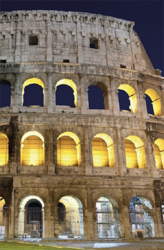
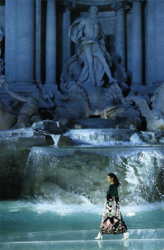
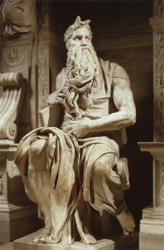

The Colosseum
The Colosseum, whose original name was the Flavian Amphitheatre, is the largest and most famous amphitheatre in existence and is known all over the world as the symbol of the city of Rome. In 1980 it was made a UNESCO World Heritage Site, and in 2007 it was the only European building included among the New Seven Wonders of the World. Work on the Colosseum was begun by Vespasian in 72 AD, and it was inaugurated by his son Titus in 80. It could hold between 50,000 and 75,000 spectators, and was used primarily for gladiator contests and other public entertainments such as wild beast hunts; the old tales of Christians being fed to the lions are, however, false. By the 6th century the amphitheatre was no longer in use, and over the centuries its stones were plundered to build palaces and churches. Today it is Rome’s most visited tourist attraction, with around 4 million visitors a year.
The Capitoline Hill
The Capitoline is the smallest of Rome’s seven hills, but the one most closely associated with the history of the Eternal City. It was originally the citadel, with the temple of Jupiter on its summit, and although in later centuries it was abandoned, it gained new life in the 16th century, when Michelangelo designed the Piazza and the majestic entrance ramp, known as the Cordonata. Sights include the Basilica of Santa Maria in Aracoeli, founded in the 4th century where legend proclaimed the emperor Augustus received from the Sybil a prophecy of the birth of Christ. Today it is the seat of Rome City Council, with Palazzo Senatorio the office of the Mayor, while the Palazzo dei Conservatori houses the splendid Capitoline Museums.
The ‘Mouth of Truth’
Inside the portico of the church of Santa Maria in Cosmedin is an ancient marble face, possibly a drain cover, with holes for its eyes and a wide open slit for a mouth. Legend tells that if a person puts their hand inside the mouth while telling a lie, the mouth will close, cutting off the hand. The story goes that a nobleman suspected his wife of adultery and took her to the Mouth to test her. On the way her lover, disguised as a madman, pretended to assault her and gave her a kiss. When, with her hand in the Mouth, she was asked if she had been faithful to her husband, she answered that she had kissed no one but him and the madman who had just forced himself on her. This was of course the truth; her hand was saved and her husband believed her. The Mouth of Truth also featured in the 1953 film Roman Holiday with Audrey Hepburn and Gregory Peck.
The Roman Forum
If you want to step back into the past, then pay a visit to the Roman Forum, one of the most important archaeological sites in the world. Once it was the beating heart of ancient Rome, noisy and crowded, the centre of social and political life. Orators argued lawsuits inside the porticos of the basilicas, attended by large crowds of listeners, while all around there rose temples to the gods and statues to heroes and statesmen. Political meetings were held here, and the triumphal processions of victorious generals passed through on their way to the Capitol. Today the ruins evoke vivid memories of the empire that once ruled the world.
Rome BioPark
Inside the Villa Borghese is the Rome Zoological Garden, known as the BioPark, where visitors can see over 200 species of animals from five continents. The BioPark is not strictly speaking a zoo, but a park devoted to the preservation of endangered species or those threatened by hunters and poachers.
The Basilica of San Pietro in Vincoli (and the Moses of Michelangelo)
San Pietro in Vincoli is one of the oldest of Rome’s churches, built in 442 at the orders of the Empress Eudoxia, the wife of Valentinian III and a fervent Christian. The church was built to hold the vincula, the chains which had bound St Peter during his imprisonment in Rome. The patriarch of Jerusalem sent to the empress’ mother another set of chains from the saint’s earlier imprisonment there, and the two chains miraculously joined together; they are now in a reliquary under the high altar. The main attraction, however, is the monumental tomb of Pope Julius II, designed by Michelangelo but never finished, which contains his extraordinary masterpiece of the statue of Moses. The statue is not only famed for its size and the power it expresses, but how Michelangelo has sculpted the body twisting one way and the head another, giving the work a kind of tensile strength, contrasting with the billowing drapery and the prophet’s flowing beard. Moses’ facial expression is especially arresting, with his frowning brows and piercing gaze. In the sacristy of the church, it is said, there was once a painting of St John the Baptist on which a teenage Giotto painted a fly, which was so life-like that several people tried to swat it away!
SOME PLACES TO VISIT IN VATICAN CITY
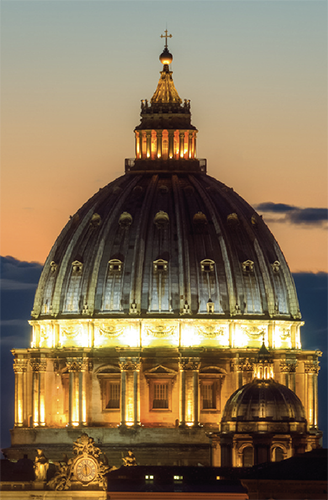
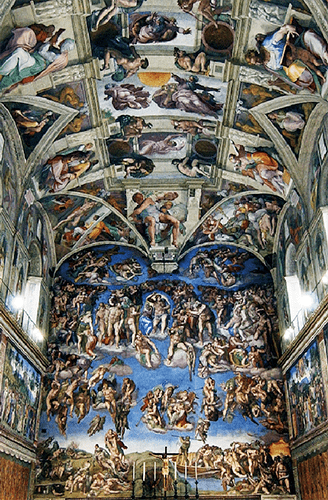
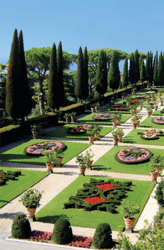
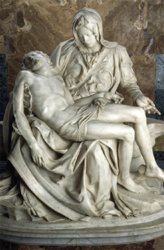
St Peter’s Basilica
The great church of St Peter’s stands at the head of Bernini’s monumental piazza, and is the mother church of the Roman Catholic faith. It is not actually in Rome at all, but inside the tiny state of the Vatican City. The first church dedicated to the first of the apostles was built in the fourth century by the Emperor Constantine on top of a cemetery where tradition claimed that St Peter was buried after his crucifixion. The building of a new basilica was begun in 1506 under Pope Julius II, and it was completed in 1626 under Urban VIII. Among the famous architects and artists who worked on the building were Bramante, Michelangelo, Carlo Maderno, Borromini and Bernini. The sumptuous façade is the work of Maderno, 100 metres wide and 50 in height; in the centre is the Loggia delle Benedizioni, where the popes stand to give their blessing and where newly elected popes are presented to the people. The vast dome was designed by Michelangelo, and is 130 metres high with a diameter of 60 metres. There are countless precious works of art inside the church, including Michelangelo’s Pietà, which he sculpted at the age of 23, the bronze statue of St Peter, attributed to Arnolfo di Cambio, the foot of which has been worn away by the kisses of the faithful, the Baldacchino, or altar canopy in gilded bronze, over 28 metres high, built by Bernini in the centre of the church above the presumed tomb of the apostle, and the magnificent interior of Michelangelo’s dome, decorated in mosaics and supported by giant pilasters containing statues by Bernini and other famous sculptors.
The Vatican Museums
Inside the Vatican City is one of the greatest collections of art in the world, put together over the centuries by succeeding popes. The Vatican Museum was founded by Julius II in the early 16th century, and the complex includes Michelangelo’s Sistine Chapel and the Papal Apartments frescoed by Raphael. There is something here for everyone: for those interested in ancient civilisations, there are the Egyptian and Etruscan Museums, and the Ethnological Museum. However, the crowning glory of the Vatican Museums is its collection of Greek and Roman art, including such masterpieces as the Apoxyomenos, the Apollo Belvedere and the dramatic Laocoon, with the Trojan priest and his sons being crushed to death by sea serpents. For lovers of painting, there is the Pinacoteca or Vatican Art Gallery, with works by Leonardo, Raphael, Titian, Caravaggio, Guido Reni and many others. Also worth a visit is the Modern Art collection, which contains works by De Chirico, Fontana, van Gogh, Gauguin, Matisse, Dali, Chagall and Francis Bacon. Even the way out of the Museums is extraordinary: by the double spiral stairway built by Giuseppe Momo in 1932, where the steps get smaller and smaller as one approaches the bottom.
The Sistine Chapel
The Sistine Chapel is perhaps the most famous place inside the Vatican. It was built between 1475 and 1481, under Pope Sixtus IV, from whom it takes its name. This is place where the conclaves are held to elect the Pope, and it is famed for the precious works of art that fill it. Apart from splendid paintings by Botticelli, Perugino and others on the side walls, the entire ceiling vault contains Michelangelo’s masterpiece The Creation of Adam and other scenes from the book of Genesis, which, like Leonardo’s Mona Lisa, is one of the most well-known artistic images in the world. On the wall behind the altar Michelangelo painted the Last Judgement, probably his greatest work, representing the Biblical second coming of Christ to judge the living and the dead.





